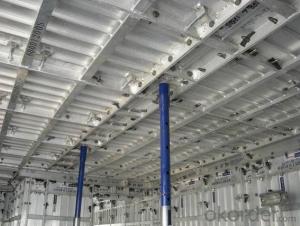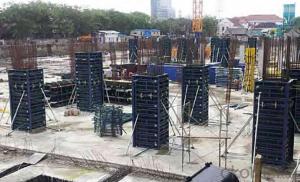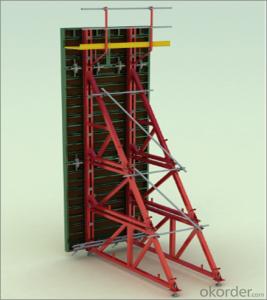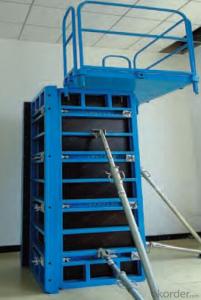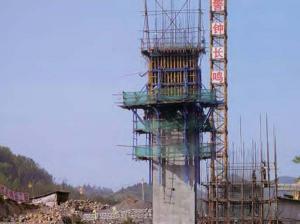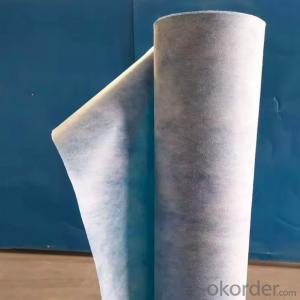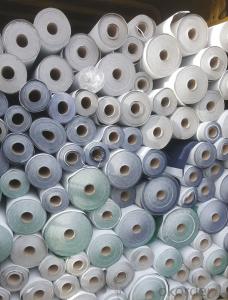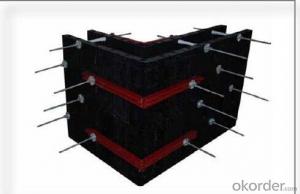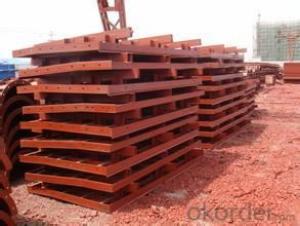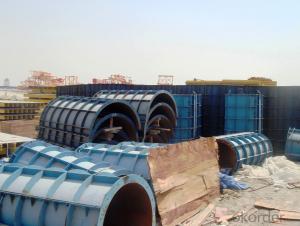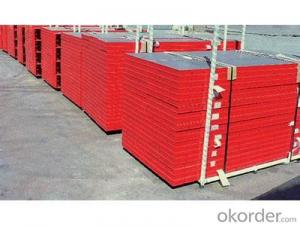Steel Frame Formwork with High Stiffness and No Assembling
- Loading Port:
- Shanghai
- Payment Terms:
- TT OR LC
- Min Order Qty:
- 1 m²
- Supply Capability:
- 100000000 m²/month
OKorder Service Pledge
OKorder Financial Service
You Might Also Like
1. Structure of Steel Frame Formwork GK120
There is a prizing part designed in the corner, which can help to position and remove formwork easily.
The plywood is screwed on from the back when connecting frame and plywood, so the surface of the finished concrete is perfect.
The formwork series are a complete system with a full set of accessories, and can be set up flexibly according to project demand.
2. Main Features of Steel Frame Formwork GK120
Light weight
High strength
High standardized system
Easy connection with adjustable steel clamp
Convenient and fast corner formwork
Flexible to assemble and application
3. Steel Frame Formwork GK120 Images
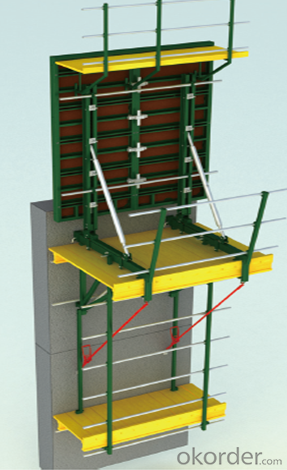
4. Steel Frame Formwork GK120 Specification
-The steel frame formwork is plywood covered with hollow steel. The plywood is 18 mm thick.
-The frame is highly strengthened, and the wall formwork can bear lateral pressure 60 KN/m2 while the column formwork can bear 80 KN/m2.
-As a standardized system, it is flexible to assemble , wood batten can be filled to satisfy the need f of non-standard size.
-The adjustable steel clamp is convenient to use, and can hold tightly.
-There is a prizing part designed in the corner, which can help to position and remove formwork easily.
-The plywood is screwed on from the back when connecting frame and plywood, so the surface of the finished concrete is perfect.
-The formwork series are a complete system with a full set of accessories, and can be set up flexibly according to project demand.
5. FAQ of Steel Frame Formwork GK120
1) What can we do for you?
.We can ensure the quality of the vinyl banner and avoid extra expenses for customers.
.We can provide you the professional design team.
.We can provide fashionable and newest styles for you.
.We can design the artwork for you.
. Please feel free to customize.
2) What promises can be done by us?
. If interested in Steel Frame Formwork GK120, please feel free to write us for any QUOTE.
. If printing required, please advise asap because the whole set need much more time to complete.
. Please DO check goods when courier knocks your door and contact us asap if any issue.
3) What about of our after-sale service?
. Response will be carried out in 24hours after receiving any complain or request.
. Steel Frame Formwork GK120 cost can be refund after order is confirmed.
. If the products are not based on the requirements, there will be the relevant compensations made for you.
4) What about the package and shipping time?
.Packing: As Customer's Requirements
.Shipping: We have various shipping ways for our customers, such as express which including TNT, DHL, FEDEX, UPS, EMS, etc. ; by air/ sea, and we are VIP of these express.
.Shipping time:
Normally small orders, it just 10-15 business days to arrive your hand; When comes to the customs declaration, it may need 7 days.
Other mass qty of Steel Frame Formwork GK120, we send them out by sea or by air to sea port or air port to save some shipping freight for our customers. By ocean, it may need 45~60days, by air, it may need 25~40days.
- Q:What are the different types of connections used in steel frame formwork?
- Steel frame formwork employs various types of connections, each serving a distinct purpose and offering different benefits. 1. Wedge connections: These connections involve using steel wedges to secure formwork panels. The wedges are inserted into pre-drilled panel holes and hammered in to create a tight and secure connection. Wedge connections are swift and effortless to assemble and disassemble, making them perfect for projects with repetitive formwork needs. 2. Clamp connections: In this type of connection, steel clamps hold the formwork panels together by gripping their edges. Clamp connections provide strong and stable connections, offering excellent strength and stability. Therefore, they are suitable for complex and heavy-duty formwork applications. 3. Pin connections: Pin connections employ steel pins to join formwork panels. The pins are inserted into pre-drilled holes and secured with nuts or other fasteners. Pin connections provide good strength and stability and are commonly used in formwork systems that require frequent adjustments or reconfigurations. 4. Bolted connections: Bolted connections utilize steel bolts and nuts to connect formwork panels. Panels are drilled with holes, and bolts are inserted through these holes and tightened with nuts. Bolted connections offer high strength and rigidity, making them appropriate for large-scale formwork systems and projects with heavy loads. 5. Magnetic connections: Magnetic connections are a recently developed type of connection in steel frame formwork. These connections use powerful magnets embedded in formwork panels to attract and hold the panels together. Magnetic connections offer quick and easy assembly and disassembly, as well as high flexibility and adaptability in formwork design. Each connection type has its own advantages and suitability for specific formwork applications. The choice of connection depends on factors such as project requirements, formwork design, load capacity, ease of assembly, and time constraints.
- Q:Can steel frame formwork be easily integrated with building information modeling (BIM) software?
- Yes, steel frame formwork can be easily integrated with building information modeling (BIM) software. BIM software allows for the creation and management of 3D models, which can include various elements of a construction project, including the formwork system. By using BIM software, the steel frame formwork can be accurately represented within the virtual model, allowing for better visualization and coordination of the construction process. Integration of steel frame formwork with BIM software offers several advantages. Firstly, it enables the design team to accurately plan and visualize the formwork system within the context of the entire building project. This helps in identifying clashes or conflicts between different elements, allowing for early detection and resolution of issues before construction begins. Additionally, BIM software can generate detailed material take-offs and quantities, improving the accuracy of cost estimates and reducing wastage of materials. Furthermore, BIM software allows for easy collaboration and communication between different project stakeholders, including architects, engineers, contractors, and formwork manufacturers. Changes made to the formwork system can be easily updated and communicated to all parties involved, ensuring everyone is working with the most up-to-date information. This leads to increased efficiency, reduced errors, and improved project coordination. In conclusion, the integration of steel frame formwork with BIM software offers numerous benefits, including improved visualization, clash detection, accurate material quantities, and enhanced collaboration. It allows for a more efficient and streamlined construction process, ultimately leading to better project outcomes.
- Q:How does steel frame formwork differ from other types of formwork?
- There are several notable distinctions between steel frame formwork and other formwork varieties. To begin, steel frame formwork is composed entirely of steel, rendering it exceptionally robust and long-lasting. It can endure substantial loads without warping or bending, making it ideal for construction endeavors necessitating considerable strength and stability. Moreover, steel frame formwork boasts exceptional adaptability. It can be easily customized and adjusted to accommodate structures of various shapes and sizes. This flexibility permits the creation of intricate and distinctive designs that would be otherwise unattainable with alternative formwork options. Furthermore, steel frame formwork guarantees superior stability and precision. The steel frames offer excellent support, ensuring that the formwork remains securely in place throughout the concrete pouring and curing process. This results in superior construction quality and heightened accuracy. Additionally, steel frame formwork enjoys a lengthier lifespan compared to other formwork alternatives. Its durability and resistance to wear and tear enable its repeated use, rendering it an economically advantageous choice in the long term. Lastly, steel frame formwork can be assembled and disassembled relatively swiftly and effortlessly. The steel frames can be conveniently transported and put together on-site, saving time and labor expenses. This efficacy proves particularly beneficial for projects with tight time constraints or limited resources. In conclusion, steel frame formwork distinguishes itself from other formwork options due to its strength, versatility, stability, durability, and user-friendliness. These qualities make it an exceptional selection for construction ventures necessitating exemplary performance and efficiency.
- Q:How does steel frame formwork prevent the formation of concrete cracking during curing?
- Steel frame formwork helps prevent concrete cracking during curing by providing strong and rigid support to the structure. The steel frame acts as a mold and holds the concrete in place, ensuring that it maintains its desired shape and form during the curing process. The steel frame formwork also helps in evenly distributing the weight and pressure exerted by the wet concrete. This prevents the formation of concentrated stress points that can lead to cracking. The strong and stable nature of steel frame formwork effectively supports the weight of the concrete, reducing the risk of sagging or deformation. Furthermore, the steel frame formwork allows for controlled and uniform drying of the concrete. By preventing rapid drying or uneven moisture evaporation, it minimizes the potential for shrinkage cracks. The formwork also helps to retain moisture within the concrete, allowing for optimal curing conditions and reducing the risk of premature drying. Steel frame formwork offers excellent dimensional stability, which ensures that the concrete maintains its intended shape and size without significant distortion. This stability prevents the formation of cracks caused by uneven settling or movement of the concrete. Overall, steel frame formwork provides a robust and reliable support system that minimizes the risk of concrete cracking during curing. It ensures that the concrete remains strong, durable, and structurally sound, reducing the need for costly repairs or remedial work in the future.
- Q:Can steel frame formwork be used for energy-efficient and sustainable construction?
- Certainly! Steel frame formwork is an excellent option for energy-efficient and sustainable construction. Its remarkable strength-to-weight ratio, durability, and recyclability make it an ideal material for sustainable construction practices. By utilizing steel frame formwork, one can create robust and reliable systems for constructing concrete structures with precision and efficiency. This not only minimizes material waste and reduces construction time but also optimizes resource utilization, thereby promoting energy efficiency. In terms of sustainability, steel is highly recyclable, meaning it can be reused or repurposed at the end of its life cycle. This effectively reduces the demand for new steel production and helps minimize the environmental impact associated with mining and extracting raw materials. Moreover, steel frame formwork can be designed to incorporate insulation materials, such as foam or mineral wool. These materials enhance the energy efficiency of buildings by providing thermal resistance, thereby reducing heat transfer and improving overall energy performance. Furthermore, steel frame formwork systems are easily dismantlable and can be reused in different construction projects. This significantly reduces the amount of construction waste generated, promoting a circular economy approach where materials and resources are kept in use for as long as possible, thus minimizing waste and maximizing efficiency. In conclusion, steel frame formwork is an ideal choice for energy-efficient and sustainable construction. Its strength, durability, recyclability, and ability to incorporate insulation materials make it an excellent option for creating environmentally friendly buildings.
- Q:What is the typical lifespan of steel frame formwork?
- The typical lifespan of steel frame formwork can vary depending on several factors such as usage, maintenance, and environmental conditions. However, with proper care and maintenance, steel frame formwork can last for several years, often exceeding 10 to 15 years.
- Q:What are the common maintenance and repair procedures for steel frame formwork systems?
- Steel frame formwork systems typically require regular inspections and maintenance tasks to ensure their durability and functionality. The following are some common procedures: 1. Regular Cleaning: It is important to clean the steel frame formwork system after each use to remove concrete residues, dirt, or debris. This can be accomplished by using water, brushes, or pressure washers. Regular cleaning helps prevent the accumulation of corrosive substances and ensures the formwork remains in good condition. 2. Rust Removal: Steel frames are prone to rust, especially when exposed to moisture or corrosive materials. Perform regular inspections of the formwork for any signs of rust or corrosion. If rust is detected, it should be eliminated using appropriate techniques such as sanding, wire brushing, or chemical rust removers. After removing the rust, apply anti-rust coatings to the affected areas to prevent future corrosion. 3. Alignment and Straightening: Over time, steel frame formwork systems may become misaligned or bent due to heavy loads or improper handling. Regularly check the alignment of the frames and ensure they are straight and level. If any misalignment or bending is observed, realign or straighten the frames using suitable tools and techniques. This is crucial to maintain the accuracy and stability of the formwork system. 4. Welding Repairs: If cracks or damages are found in the steel frames, welding repairs may be necessary. Trained professionals should perform welding using appropriate techniques and equipment. This ensures the structural integrity of the formwork system and prevents further damage. 5. Lubrication: Some steel frame formwork systems have moving parts, such as hinges or adjustable components. Regularly lubricate these parts with suitable lubricants to prevent friction and ensure smooth operation. Lubrication also helps protect the system from rust and corrosion. 6. Inspection of Accessories: Alongside the steel frames, it is important to inspect and maintain the accessories and components of the formwork system, such as nuts, bolts, pins, and clamps. Regularly check these items for any signs of wear, damage, or corrosion. Promptly replace any damaged or worn-out accessories. 7. Storage and Handling: Proper storage and handling of the steel frame formwork system are crucial for its longevity. Store the formwork in a dry and well-ventilated area to prevent moisture accumulation. Avoid excessive stacking, as this can cause deformation or damage. When handling the formwork, use appropriate lifting equipment and techniques to prevent accidents and minimize stress on the frames. By adhering to these common maintenance and repair procedures, steel frame formwork systems can be maintained in optimal condition, ensuring their longevity and reliability in construction projects.
- Q:How does steel frame formwork contribute to sustainable construction practices?
- Steel frame formwork contributes to sustainable construction practices in several ways. Firstly, steel is a highly durable and long-lasting material, which means that the formwork can be reused multiple times, reducing the need for new materials and minimizing waste. This reusability also leads to cost savings and a more efficient construction process. Additionally, steel frame formwork is highly adaptable and can be easily modified to suit different project requirements, reducing the need for new formwork designs and materials. This flexibility improves construction efficiency and reduces the overall environmental impact. Furthermore, steel is a recyclable material, and at the end of its life cycle, the formwork can be recycled and used in other construction projects, reducing the demand for new steel production and conserving natural resources. Overall, steel frame formwork promotes sustainable construction practices by reducing waste, improving efficiency, and supporting the principles of circular economy through its reusability and recyclability.
- Q:Can steel frame formwork be used for educational and institutional buildings construction?
- Yes, steel frame formwork can be used for educational and institutional buildings construction. Steel frame formwork provides a sturdy and durable structure that can withstand the demands of constructing such buildings. It offers flexibility in design and can be easily adapted to various architectural requirements. Additionally, steel frame formwork allows for efficient construction processes, ensuring timely completion of the project.
- Q:How does steel frame formwork handle the removal of formwork after concrete curing?
- In the construction industry, steel frame formwork is highly favored due to its durability and strength. When it comes to removing formwork after concrete has cured, steel frame formwork offers numerous benefits. To begin with, steel frame formwork is designed for easy disassembly and removal. The formwork system comprises interconnected steel frames that utilize various fastening mechanisms like clamps or bolts. This facilitates a swift and efficient dismantling process, minimizing downtime and labor costs. Furthermore, steel frame formwork boasts exceptional load-bearing capacity. It can support the weight of the concrete during the curing process, eliminating the need for additional supports. Consequently, removing the formwork is relatively straightforward as the steel frames can be safely lifted and detached without compromising the integrity of the concrete structure. Moreover, steel frame formwork is reusable, making it a cost-effective option. Once the formwork is removed, it can be cleaned, inspected, and prepared for future projects. This not only reduces material waste but also saves money on purchasing new formwork for each construction project. Additionally, steel frame formwork ensures a smooth and even finish on the concrete surface. The rigid and stable design of the steel frames guarantees that the concrete retains its shape and structure throughout the curing process. This results in a high-quality finish, reducing the need for additional surface treatments or repairs after removing the formwork. Overall, steel frame formwork is a dependable and efficient solution for handling formwork removal after concrete has cured. Its ease of disassembly, load-bearing capacity, reusability, and ability to produce a smooth finish make it the preferred choice for construction projects.
1. Manufacturer Overview |
|
|---|---|
| Location | |
| Year Established | |
| Annual Output Value | |
| Main Markets | |
| Company Certifications | |
2. Manufacturer Certificates |
|
|---|---|
| a) Certification Name | |
| Range | |
| Reference | |
| Validity Period | |
3. Manufacturer Capability |
|
|---|---|
| a)Trade Capacity | |
| Nearest Port | |
| Export Percentage | |
| No.of Employees in Trade Department | |
| Language Spoken: | |
| b)Factory Information | |
| Factory Size: | |
| No. of Production Lines | |
| Contract Manufacturing | |
| Product Price Range | |
Send your message to us
Steel Frame Formwork with High Stiffness and No Assembling
- Loading Port:
- Shanghai
- Payment Terms:
- TT OR LC
- Min Order Qty:
- 1 m²
- Supply Capability:
- 100000000 m²/month
OKorder Service Pledge
OKorder Financial Service
Similar products
New products
Hot products
Hot Searches
Related keywords
